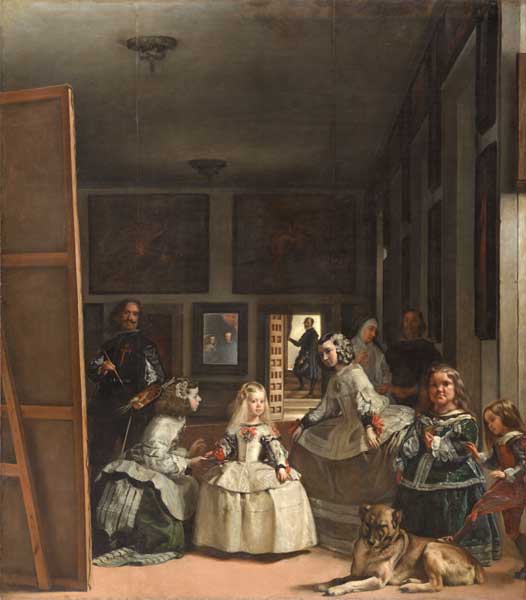I keep a postcard of Velázquez’s Las Meninas above my desk at work, and I can’t look at it without thinking of the summer I spent in Spain with R, the last summer we were friends.
That summer I was an ugly American tourist. I did not wear inappropriate clothes or go around demanding things in English. But I was self-centered in a manner that strikes me as both particularly American and white and adolescent: caught up in my own private goals and attached to the expectations I’d had before arriving. I wanted to go the Prado. I wanted to see Las Meninas up close.
I probably remarked at least once a day about it: “Could we go the Prado?” R had been an exchange student the previous year at my rural public high school, where we’d met in an art class. We actually went to the museum on my first or second day in Madrid, but we rushed so quickly through the halls and missed all of Velazquez and Goya, so I was not satisfied. An ugly American is never satisfied.

I mentioned returning to the museum while dancing with R’s friends at discotecas, while lounging for hours around the pool in R’s father’s apartment complex in Madrid. I thought about it while reading Their Eyes Were Watching God in Tarragona, where R’s mother worked. The air was humid and still. Internally, I was on the churning sea of a new loneliness.
I wish I could whisper in my young self’s ear: relax a little. Dance harder. Lounge away. Ask a lot of questions (not just about the Prado).
But relaxing wasn’t really my thing. R’s mother worried I was too serious. I was. In my journal, I wrote anxious sentences about wanting to see the “real” Spain. At the time, this meant buildings and burnt-orange landscapes and this particular painting in this particular museum. I was familiar with Las Meninas from my mother’s art history textbooks from college, and I felt drawn to the pale Infanta Margarita Teresa, whose quiet gaze radiates the relaxed confidence I was short on as a child.
In the third grade, I’d decided to live someday in Spain and learn how to dance flamenco. Now I can’t remember what led me to this exact decision—probably some diorama I’d created for a social studies project. I made a lot of dioramas in those days, and in setting up little tableaus, I wanted to jump into them, into other people’s lives. I wasn’t aware there might be emotional work involved in making such a jump for real. Or that part of the work is about letting go of your own comfort.
I was blind to how much of that work R had done already. For the year before my visit in Spain, she had been a wonderful friend—thoughtful and patient, with a beautiful, gravelly voice often punctuated by laughter. We spent nights at each other’s houses, staying up all night talking, sometimes in Spanish, which she was patient about speaking with me. I remember her being both talented and modest about her drawings. I remember her braiding my hair for the junior prom.
She was enthusiastic about everything except feet—she hated bare feet. Toes were the worst and made her almost retch with revulsion. But other than her toe-phobia, she had no complaints, not that she expressed to me, and it never occurred to me that she might find living in rural central New York a challenge.
I didn’t realize it until after I’d been moping and insufferable for days in Madrid. “You’re homesick,” R said. “You don’t think I was homesick, too?” And then she basically suggested I needed to grow up.
In addition to facing her mother getting remarried, there were other transitions R had to make that summer. First and foremost, reconnecting with old friends after living in the middle of nowhere, USA—nowhere to dance, nowhere to drink, and host parents with strict curfews.
I had a car-less, curfew-filled life to contend with back home, too, but though I complained about it, I was used to it. I was used to quiet nights watching movies with one or two friends. Groups had always intimidated me, especially groups of my peers. I was happiest with a book or on a walk on country roads. I hadn’t thought about how lonely that had been for R.
For a while that summer, adults faded into the background. In their place we had public transportation and the legal right to drink. R and I stayed out dancing all night and didn’t arrive home until 5am. Everywhere we went in the capital, we were surrounded by R’s old friends and cousins and the new friends we met at parties and clubs.
In Madrid, surrounded by young people and their conversations and casual acceptance of my halting Spanish, I gradually emerged from my self-induced state of exile. One night, R and I went with her boyfriend and his friends to a park, and while she and he made out under a tree, another of the boys and I sat and watched the stars. For some reason we were talking about isosceles triangles. I’d never liked geometry, but being able to talk about it in Spanish made me happy.
Unfortunately I felt the waves of this new pleasure in my last week, and it almost felt too late. I regretted spending all that time worrying about the Prado.
When I finally did see Las Meninas, I felt both dwarfed and elevated by its dimensions. It’s the kind of painting that transcends its frame; looking at it life-sized feels more like watching a play than standing passively in a museum. I immediately became part of the drama of light and shadow and perspective, and I felt it bodily—a shivery acknowledgment of great and important beauty. Up close, the Infanta’s penetrating gaze got to me.
I hold on to a memory of R bent over a drawing in art class, straight dark hair hiding deep concentration. But that day in Madrid she seemed to have no interest in talking about Las Meninas. Or maybe I just didn’t know how to put into words my relief at having seen the painting. More likely: R was probably already tired of hearing me talk about the Prado and grateful that now I could finally shut up about it.
I’d been such a broken record about this face, this painting, this museum. My homesickness had made me needy for the easy comfort of the two-dimensional world, and now that embarrassed me. In the end, I had gotten what I wanted, and that’s another thing that strikes me as perfectly American and entitled: complain long enough, and folks will do anything to get you to stop complaining.
Driving away from the Prado, with R silent in the backseat next to me, I felt embarrassed to recognize this privilege, and sad to watch what I already knew was the end of a good friendship.
R and I reconnected only once: when she returned to my hometown to visit her host parents. I was in college by then, but I still didn’t have a car. In preparation for the visit, I remember dyeing my hair for the first time. I suppose I wanted to appear grown up finally, or just different—though in retrospect the choice seems a little on-the-nose.
My mother dropped me off at the house R had lived in for a year—a woodsy place down a long, dirt driveway—and a larger worry crept in, right next to the excitement I felt about seeing R again.
Inside, this worry was confirmed: our relationship, once easy, felt strained. I don’t remember if she remarked on my hair. She looked the same, the same beautiful R. We ate dinner, maybe watched a movie, discussed boys. I don’t remember if we talked about my visit in Spain. Maybe she was being kind—avoiding what we knew wasn’t my finest moment.
Up close, the Infanta appears not just confident, but royally skeptical: her head turned slightly, away from her Lady in Waiting, who appears on her knee, beseeching.
Seeing her seeing me was a revelation—not just of art’s power to enlighten, but of my own shortcomings. I knew that the joy I felt in witnessing the painting would always be tinged with regret. Which is not necessarily a bad thing. Regret isn’t joy’s opposite, but its complement. When, years later, I lived in Ireland and Colombia and China, I sometimes had glimmers of that brand of loneliness that only comes when very far away from home. But in those cases, the loneliness usually served as a useful warning sign: stop looking inward. Listen, wait, there’s something you don’t truly see.
The last night I saw R, we shared a bed the way we used to, and there were moments when we laughed so hard we cried. When we laughed, I felt relieved, as if everything had returned to the way it had been before I’d completely revealed myself to her. But the relief couldn’t last. When my bare feet touched her by accident under the sheets, she yelled in disgust and moved further away. The last thing I remember is turning off the lights.





Jonathan Efemey says
I studied Las Meninas as part of my art history dissertation as part of my Fine Art degree at the University of Newcastle upon Tyne way back in 1974.
I have seen this masterpiece twice at the Prado and spent hours studying it.
I rate it as one of the greatest paintings.
There is so much to look at in terms of composition and the use of paint but the subject matter is really fascinating.
Yes it is about the presentation of the ‘ pale Infanta Margarita Teresa’. Being a Habsburgs she died in her teens. For me the relationship of Philip IV to Velazquez in the painting. So Velazquez is at the front of the painting painting the scene, but the King and Queen are shown in the mirror at the back looking in from the front? Much else is going on.